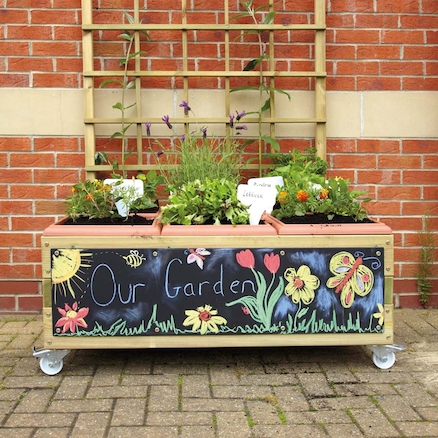Many of us are familiar with that refreshed, calm sensation we feel after going on a long walk or spending a few hours in the garden. All our worries, never ending to-do lists and feelings of stress start to melt away after spending time outside. It’s a long way from the day-to-day experience as a teacher!
Yet when we discuss teacher wellbeing, the connection to nature that our minds and bodies enjoy, is rarely mentioned. Instead, we focus on healthy eating, exercise, meditation, water consumption, rest – which are all valid areas for consideration. But when we take things down to a human level, it becomes apparent that we have an inherent need to be surrounded by nature and neglecting it can have a negative impact on our mental health.
Proven benefits
“There’s a bit more to it than just breathing in fresh air and feeling the sun on our skin.”
Let’s take the sensation we feel after being outside for an extended period as an example. One study using MRI scans and visual imagery found that when presented with a visual of an urban environment the frontal lobe, hippocampus and amygdala showed high levels of activity. These areas of the brain are responsible for executive functions like planning and organising, learning and memory and also processing threats.
Whereas when presented with natural imagery the temporal, parietal and occipital lobes were dominant. These areas of the brain are responsible for processing emotions, sensory feedback and visuospatial processing (Kim et al 2010).
From this we can conclude that urban environments are highly stimulating for our minds; triggering our subconscious fear response and processing functioning, causing our minds to go into overdrive. In contrast, a natural environment enables our brains to process how we have been feeling in ourselves and become present with the sensations and sights surrounding us. When equipped with this understanding, we can see how spending time in natural environments could be very beneficial for supporting mental wellbeing.

But how does this relate to the practicalities of teaching and supporting teacher wellbeing?
Teachers can hardly spend their days swanning off into nature, and with heavy workloads it can be difficult to carve out the time in our personal lives. So, to help you support your own wellbeing, here’s how we can harness the power of connecting to nature within our busy, everyday teaching practice!
1. Bring the outdoors in
There’s been a huge trend towards neutralising our classrooms in recent years to reduce sensory stimulation. But given what we know about natural environments, we need to go a step further and bring as much nature into our classrooms as we can too.
Some simple ways to do this are:
- Use natural loose parts such as sticks, pinecones and shells in your teaching instead of typical classroom equipment such as multi-link or counters.
- Introduce some low maintenance houseplants to your classroom and around school. Spider plants are fantastically resilient and will survive weeks without watering if you forget!
2. Add more nature to your school grounds
A study by Davand et al (2015) found ‘an improvement in cognitive development associated with surrounding greenness, particularly with greenness at schools.’ The findings of this study suggest that simply having a green space within sight, out of your classroom window, can boost working memory and attentiveness in children. Adding greenery into your outdoor space doesn’t need to be extravagant or expensive. Growing from cuttings taken from staff members’ gardens can be a great cost-effective way to add more natural planting to your outdoor space. If you’re lacking in ground space to plant, add planters! Most DIY stores have a community scheme where you can obtain wood to make planters either freely or very cheaply – simply go into the store and ask the manager!

3. Take your everyday lessons outdoors
The best way to benefit from the outdoors and boost your wellbeing is to actually go and spend time out there! This doesn’t have to be a Forest School session or anything additional to the curriculum you’re already teaching either. Taking your maths, science or any area of curriculum outside is possible! For free ideas and inspiration, you can download some free planning bundles for KS1, LKS2 & UKS2 here – www.alfrescolearning.co.uk.
Using natural loose parts, your outdoor environment and everyday school equipment enables you to take learning outside into a more natural environment. This facilitates free movement and enables both yourself and your children to reap the benefits of nature to support your wellbeing. But be warned, once you get started with curriculum outdoor learning, you will find it hard to stop! You’ll quickly realise that when you head back indoors after your session, you get to experience that refreshed and energised feeling and you’ll soon find yourself craving more of this during your week!
Time to get outdoors!
With so much science and research to explain how nature refreshes your mind’s executive functions, supports the processing of emotions and deepens a connection to your surroundings, it is time we harness these benefits for ourselves as teachers. Now you have become aware of exactly how nature can benefit your brain; you can start to work nature into your everyday teaching practice and even perhaps share these pieces of research with your colleagues to empower them to connect with nature too.

With many thanks to Hollie Hindle for writing this blog.
Hollie is Co-Founder of Alfresco Learning – an outdoor learning company dedicated to combining the National Curriculum with nature to create an inclusive learning approach and provide memorable learning experiences for all children. Through staff training & an online planning hub, they aim to help primary teachers unlock their own potential in taking their everyday lessons outdoors.



